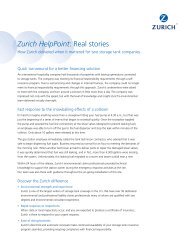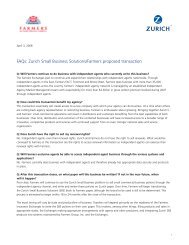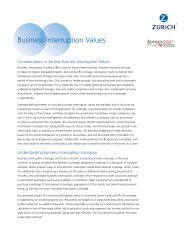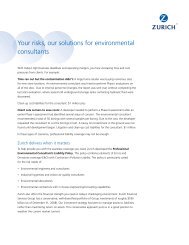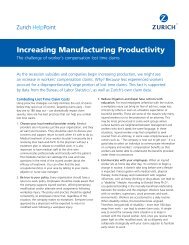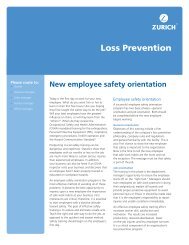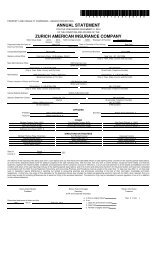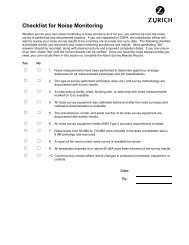Know the risks - Zurich
Know the risks - Zurich
Know the risks - Zurich
Create successful ePaper yourself
Turn your PDF publications into a flip-book with our unique Google optimized e-Paper software.
• Reviewing how appropriate financial and operational information is provided tosenior management and board members• Evaluating <strong>the</strong> overall effectiveness of <strong>the</strong> board“Typical lawsuits broughtagainst directors of depositoryinstitutions for breaching <strong>the</strong>irduty of care include:1. Failure to supervise2. Failure to implementappropriate complianceprograms3. Negligent lending andreserving practices4. Failure to respond towarnings or criticismsfrom regulators, auditorsand o<strong>the</strong>rs”Directors are entitled to rely on information, opinions, reports or statements,including financial statements or o<strong>the</strong>r data, prepared by employees, legal counsel,public accountants or o<strong>the</strong>r experts or professionals, or committees of <strong>the</strong> board ofdirectors if <strong>the</strong> directors reasonably believe that such sources merit confidence. Ofcourse, directors may not rely upon <strong>the</strong>se people if <strong>the</strong>y have knowledge of facts orinformation that would make this reliance unwarranted.Examples of lawsuits typically brought against directors of depository institutions forbreaching <strong>the</strong>ir duty of care include <strong>the</strong> following:1. Failure to superviseDirectors have a duty to supervise o<strong>the</strong>r directors, as well as <strong>the</strong> institution’s officers.While a director may not be directly involved in fraud or embezzlement, <strong>the</strong> directormay be liable if he or she failed to establish or follow adequate internal controls.State and federal regulators may pursue directors for failing to exercise adequatesupervision. Most notably, regulatory agencies will often sue directors of an insolventdepository institution for negligence and breach of fiduciary duty, as well as breachof various statutory duties, based on <strong>the</strong> directors’ failure to supervise or adequatelydirect management after unsafe practices have been called to <strong>the</strong> directors’ attention.The supervisory role of directors is of particular importance as depository institutionsexpand into new lines of business. The decision to enter a new line of business mustbe carefully considered. Acquisitions and entries into new lines of business should beundertaken only after development and analysis of a business plan prepared with <strong>the</strong>assistance of consultants or advisors with established expertise in <strong>the</strong> new business.Managing <strong>the</strong> new business may require special skills or expertise unavailable amongexisting personnel, and <strong>the</strong> depository institution may be exposed to market factorsand <strong>risks</strong> of a nature and magnitude different from those affecting <strong>the</strong> institution’straditional operations.2. Failure to implement appropriate compliance programsA director’s duty of care includes a duty to establish internal compliance programsto identify and curtail misconduct by an institution’s employees and agents, as wellas a duty to monitor those programs to be sure <strong>the</strong>y are effective.Courts used to be reluctant to require directors to take affirmative steps to implementinternal compliance programs – unless, of course, <strong>the</strong>re were obvious problems ofwhich <strong>the</strong> directors should have been aware. No more. It is now clear that a director’sduty of care includes an affirmative obligation to establish and maintain programs tomonitor whe<strong>the</strong>r <strong>the</strong> institution is complying with applicable law.3. Negligent lending and reserving practicesMany cases brought against depository institution directors have involved improper,unauthorized, excessive or badly documented loans or overdrafts. One recurrentproblem is <strong>the</strong> lending of excessive amounts to one borrower or an affiliated group5Financial institutions guide
of borrowers. Directors who allow loans to be approved in excess of an institution’slending limits may be liable for <strong>the</strong> entire amount of <strong>the</strong> improper loan. 4O<strong>the</strong>r common examples of negligence in lending include:• Failing to obtain financial statements and o<strong>the</strong>r adequate information about <strong>the</strong>credit standing of borrowers• Lending on inadequate security or without a proper appraisal• Lending to favored borrowers or “cronies”• Lending to businesses run by persons with little or no experience• Permitting a large volume of delinquent or classified loans to build up• Failing to establish adequate reserves or overreserving• Permitting undue concentration of loans in a single industry or field of activity(e.g., commercial construction)4. Failure to respond to warnings or criticisms from regulators, auditorsand o<strong>the</strong>rsOften, regulators or private auditors will render an audit or examination reportcontaining specific criticisms of a depository institution’s lending practices oroperations. Directors who ignore <strong>the</strong>se warnings act at <strong>the</strong>ir own peril. Manycomplaints against directors allege that <strong>the</strong>y were aware of problems with <strong>the</strong>institutions’ practices, yet failed to establish or adhere to policies designed torespond to those warnings and criticisms.The “Business Judgment” RuleThe actions of directors undertaken in good faith and for a rational business purposewill ordinarily be protected by <strong>the</strong> “business judgment” rule, which means that <strong>the</strong>courts will not overturn corporate decisions and substitute <strong>the</strong>ir own judgment for<strong>the</strong> business judgment of <strong>the</strong> directors. As one court has stated:Directors of corporations discharge <strong>the</strong>ir fiduciary duties when in good faith <strong>the</strong>yexercise business judgment in making decisions regarding <strong>the</strong> corporation. When<strong>the</strong>y act in good faith, <strong>the</strong>y enjoy a presumption of sound business judgment,reposed in <strong>the</strong>m as directors, which courts will not disturb if any rational businesspurpose can be attributed to <strong>the</strong>ir decisions. In <strong>the</strong> absence of fraud, bad faith,gross overreaching or abuse of discretion, courts will not interfere with <strong>the</strong>exercise of business judgment by corporate directors. 54 See, e.g., Corsicana National Bank v. Johnson,251 U.S. 68 (1919).5 Panter v. Marshall Field & Co., 646 F.2d 271,293 (7th Cir. 1981). Directors are cautioned that<strong>the</strong> business judgment rule has been stated indifferent ways by different courts. Whe<strong>the</strong>r aparticular court will apply <strong>the</strong> business judgmentrule in a particular case may depend on <strong>the</strong>court’s “feel” for whe<strong>the</strong>r <strong>the</strong> directors actedwith reasonable care under <strong>the</strong> circumstances.6Financial institutions guide
While <strong>the</strong> scope and application of <strong>the</strong> “business judgment” rule differ from stateto-state,<strong>the</strong>re are five prerequisites that must generally be present before <strong>the</strong> rulewill apply:• There must be a business decision. The rule protects directors in connection withaffirmative decisions that comply with <strong>the</strong> rule, but not for inaction or generalfailures of oversight.• The directors must be disinterested. The rule protects directors who aredisinterested and independent, but not directors who appear on both sides of atransaction or who expect to derive any personal financial benefit from it.• The directors must act with due care. The rule protects directors who reach aninformed decision after making a reasonable effort to identify and evaluate allrelevant information reasonably available to <strong>the</strong>m and who reasonably deliberate<strong>the</strong> decision. 6• The directors must act in good faith. The rule protects directors who actwith a good faith belief that <strong>the</strong>ir business decision is in <strong>the</strong> best interests of<strong>the</strong> corporation.• The directors must not abuse <strong>the</strong>ir discretion. The rule protects directors againsthonest errors of judgment, but not for decisions that cannot be supported bysome rational basis and are egregious on <strong>the</strong>ir face.A plaintiff challenging a director’s decision bears <strong>the</strong> burden of proving that at leastone of those elements is not present. If a plaintiff is able to do so, <strong>the</strong> burden shifts to<strong>the</strong> director to prove <strong>the</strong> “entire fairness” of <strong>the</strong> transaction. 7 This “entire fairness”standard can be a very high burden because <strong>the</strong> director must establish his or herutmost good faith and <strong>the</strong> most scrupulous inherent fairness of <strong>the</strong> transaction, bothin terms of fair dealing and fair price. 8 A director’s subjective belief as to <strong>the</strong> fairness ofa transaction is not sufficient for this purpose.6 See, e.g., Smith v. Van Gorkom, 488 A.2d 858(Del. 1985).7 Grobow v. Perot, 539 A.2d 180 (Del. 1988).8 Cede & Co. v. Technicolor, Inc., 634 A2d 345(Del. 1993).9 In re Walt Disney Co. Derivative Litig., 825 A.2d275 (Del. Ch. 2003).10 In re The Walt Disney Company DerivativeLitigation, 2005 Del. Ch. LEXIS 113 (Aug. 9,2005)11 Id.Board decisions regarding executive compensation have become one of <strong>the</strong> morefrequently litigated issues under <strong>the</strong> “business judgment” rule in recent years. Theprotracted and highly-publicized litigation challenging Disney’s payment of severancecompensation to Michael Ovitz is reflective of <strong>the</strong> trend of increased litigationregarding compensation arrangements that are or appear to be excessively generousor poorly structured. In a commonly-cited pre-trial opinion, <strong>the</strong> Delaware ChanceryCourt held that <strong>the</strong> “business judgment” rule did not protect Disney’s directors fromallegations that <strong>the</strong>y failed to evaluate, negotiate or approve Ovitz’s employmentagreement. 9 Following a lengthy trial, <strong>the</strong> Court eventually ruled that Disney’s directorsdid in fact act in good faith and, <strong>the</strong>refore, were not liable. 10While <strong>the</strong> Court recognized that many aspects of Ovitz’s hiring and termination“reflect[ed] <strong>the</strong> absence of ideal corporate governance,” <strong>the</strong> court never<strong>the</strong>lessultimately deferred to <strong>the</strong> directors’ good faith judgment. 117Financial institutions guide
Statutory and regulatory dutiesIn addition to <strong>the</strong> common law duties discussed above, federal and state statutesand regulations impose fur<strong>the</strong>r obligations and limitations upon directors andprovide means for supervising and enforcing those requirements. The following setsforth an overview of <strong>the</strong> most prevalent duties and requirements imposed upondirectors by those statutes and regulations:Qualifications and restrictions on board membershipUnlike o<strong>the</strong>r institutions, directors of national banks must meet certain eligibilityrequirements, including citizenship and residence. 19 Upon appointment orelection, a director of a national bank must take an oath that he or she will“diligently and honestly” administer <strong>the</strong> affairs of <strong>the</strong> bank and that he or shewill not “knowingly violate or willingly permit to be violated” any provision of<strong>the</strong> National Bank Act. 20 Independent of <strong>the</strong> common law duties of directors, thisoath requires a director of a national bank to take steps to ensure that <strong>the</strong> bankobserves applicable laws and regulations.Various provisions of federal law fur<strong>the</strong>r prohibit or restrict bank directors from servingas directors or officers of o<strong>the</strong>r types of institutions or o<strong>the</strong>rwise regulating suchrelationships. 21 For instance:• Except in certain limited circumstances, no director or officer of any member bankof <strong>the</strong> Federal Reserve System may be at <strong>the</strong> same time a director or officer of anyo<strong>the</strong>r bank organized under <strong>the</strong> National Bank Act or state law. 22• Federal law prohibits a director of any depository institution with assets exceeding$2.5 billion from serving as a director of any o<strong>the</strong>r nonaffiliated depositoryinstitution having assets exceeding $1.5 billion. 23• There are statutory restrictions on interlocks between depository institutions in <strong>the</strong>same geographical area. 24• Individuals who have been convicted of any criminal offense involving dishonestyor a breach of trust may serve as bank directors only with prior FDIC approval. 25In addition, many states impose o<strong>the</strong>r requirements for directors of statecharteredinstitutions.Heightened duties and liabilities for depository institutions19 12 U.S.C. § 72.20 Id.21 For example, 16 U.S.C. § 825(b) (publicutilities), 15 U.S.C. § 79q(c) (public utilityholding companies), and 15 U.S.C. § 80a-10(c)(investment companies).22 15 U.S.C. § 19.23 12 U.S.C. § 3203.24 12 U.S.C. § 3202, et seq.25 12 U.S.C. § 1829.A director of a depository institution may be personally liable under 12 U.S.C. §93 for violations by a bank or its officers, agents or employees of <strong>the</strong> provisionsof <strong>the</strong> National Bank Act, if <strong>the</strong> director participates in or permits such violations.This potential statutory liability is in addition to any civil liability for any breach by adirector of his common law duties. Even so, a bank director does not automaticallybecome an insurer against all losses suffered in connection with an unlawful actof <strong>the</strong> bank. In order for a bank director to be personally liable under 12 U.S.C. §93, <strong>the</strong> director must “knowingly violate, or knowingly permit any of <strong>the</strong> officers,9Financial institutions guide
agents, or servants of <strong>the</strong> [bank] to violate” <strong>the</strong> statute in question. Courts havesaid that a deliberate refusal to investigate that which <strong>the</strong> director has a dutyto investigate is tantamount to an intentional violation of <strong>the</strong> law, subjectinga director to personal liability for resulting losses. 26 Accordingly, bank directorsshould familiarize <strong>the</strong>mselves with <strong>the</strong> laws applicable to national banks in orderto recognize when <strong>the</strong>re may be a duty to investigate. Bank directors will not beexcused from this duty simply because <strong>the</strong>y lack an understanding of <strong>the</strong> pertinentstatutes and regulations.National banks are subject to limitations on <strong>the</strong> amount <strong>the</strong>y may lend to a singleborrower based on <strong>the</strong> bank’s capital and surplus and a national bank may not makea loan secured by its own stock. Bank directors who knowingly violate or knowinglypermit violations of any such limitations may be personally liable under <strong>the</strong> NationalBank Act. 27A wide array of o<strong>the</strong>r statutory and regulatory provisions govern <strong>the</strong> operation ofdepository institutions, including:• Depository institutions must maintain certain specified reserves and are subject torestrictions on paying dividends. 28• Depository institutions must make periodic reports as required by law. 29• Loans to “insiders” must be made on substantially <strong>the</strong> same terms, includinginterest rates and collateral, as those prevailing at <strong>the</strong> time for comparabletransactions with o<strong>the</strong>r persons and must not involve more than <strong>the</strong> normal risk ofrepayment or present o<strong>the</strong>r unfavorable features. 30• Depository institutions may not engage in impermissible “tying” arrangements. 31Directors who violate or participate in violations of those statutes and regulationscould be liable to <strong>the</strong> same extent as <strong>the</strong> financial institution.Regulatory Examinations26 Corsicana National Bank v. Johnson, supra at71-72; Michelsen v. Penney, 135 F.2d 409, 420(2d Cir. 1943).27 See, e.g., del Junco v. Conover, 682 F.2d 1338,1341-42 (9th Cir. 1982), cert. denied 103 S.Ct.786 (1983).28 12 U.S.C. § 60.29 12 U.S.C. § 161. See, e.g., Chesbrough v.Woodworth, 244 U.S. 72, 76 (1917); Harmsenv. Smith, 542 F.2d 496, 500 (9th Cir., 1976).30 12 U.S.C. § 375b(2)(a).31 12 U.S.C. §§ 1971, et seq. “Tying” isconditioning credit or <strong>the</strong> availability ofo<strong>the</strong>r services upon a customer’s agreementto engage in additional credit or servicetransactions with <strong>the</strong> bank or its affiliates.An examination report may be <strong>the</strong> most important vehicle for <strong>the</strong> ongoing regulatorysupervision and enforcement of <strong>the</strong> duties of depository institutions and <strong>the</strong>irdirectors. In making periodic examinations, <strong>the</strong> regulator will assess <strong>the</strong> quality of <strong>the</strong>institution’s assets, match assets with liabilities to evaluate liquidity and earnings, andreview management practices and capabilities. The report will specify any concerns<strong>the</strong> regulator may have with respect to <strong>the</strong> institution’s operations and may makerecommendations or suggest goals for <strong>the</strong> institution to pursue. Directors shouldreview carefully all examination reports to inform <strong>the</strong>mselves of <strong>the</strong> examiner’sanalysis of <strong>the</strong> institution’s operations and to ensure that management is acting tocorrect any identified problems.FIRREAIn 1989, Congress enacted <strong>the</strong> Financial Institutions Reform, Recovery andEnforcement Act of 1989 (FIRREA) in response to <strong>the</strong> rise in failures of depositoryinstitutions. FIRREA enhanced <strong>the</strong> enforcement powers of <strong>the</strong> Federal Deposit10Financial institutions guide
Insurance Corporation (FDIC) in two respects: (1) <strong>the</strong> FDIC was given broad authorityover federally insured banks and savings associations; and (2) <strong>the</strong> FDIC was givenpower to bring enforcement actions against any “institution-affiliated party,” which isdefined to include, among o<strong>the</strong>r things, any director, officer, employee or controllingstockholder (o<strong>the</strong>r than a holding company) of an insured depository institution.In addition to administrative remedies such as issuing cease and desist orders,suspension or removal from office, and prohibition orders, FIRREA empowers <strong>the</strong>FDIC to impose civil money penalties against institution-affiliated parties, includingindividuals who have left <strong>the</strong> institution, or individuals associated with institutionsthat are now closed. FIRREA sets forth three levels of civil money penalties that maybe imposed against an institution-affiliated party, ranging from less than $5,000to $1 million per day for continuing violations. Criminal penalties may range from$100,000 per day and one year’s imprisonment to $1 million per day and 20 years’imprisonment. These penalties also apply to violations of anti-tying provisions of <strong>the</strong>Bank Holding Company Act, <strong>the</strong> Change in Bank Control Act, affiliate transactionrestrictions, and <strong>the</strong> National Bank Act.Statutory and common laws governing <strong>the</strong> responsibilities of directors of financialinstitutions vary from state to state. Historically, a director’s acts or omissions weretested against an ordinary prudent person standard. However, at least 43 states haveenacted statutes permitting corporations to adopt charter provisions that limit oreliminate <strong>the</strong> liability of directors (and, in some states, officers) for breach of <strong>the</strong> dutyof care. FIRREA, however, limits <strong>the</strong> ability of depository institutions to eliminate adirector’s liability for gross negligence.“Functional regulation”The Gramm-Leach-Bliley Act of 1999 changed how depository institutions and <strong>the</strong>irholding companies and affiliates are regulated. The Gramm-Leach-Bliley Act promotes“functional regulation,” meaning that traditional depository institution activitiesare regulated by depository institution regulatory agencies, securities activities areregulated by <strong>the</strong> Securities and Exchange Commission (SEC), insurance activities areregulated by <strong>the</strong> states, and so on.Many depository institutions offer securities, mutual funds and o<strong>the</strong>r types ofinvestments to customers as alternatives to traditional deposit instruments. Customersmay misunderstand <strong>the</strong> nature of non-deposit products because <strong>the</strong> products are oftensold within <strong>the</strong> institution’s premises by <strong>the</strong> institution’s employees. In many instances,personnel are required to register as brokers (or dealers) with <strong>the</strong> SEC and NationalAssociation of Securities Dealers. Moreover, <strong>the</strong> products offered may be “securities”under federal or state securities laws which must be registered with <strong>the</strong> SEC and/orstate agencies. And, under <strong>the</strong> Gramm-Leach-Bliley Act, depository institutions that actas advisers to mutual funds must register with <strong>the</strong> SEC as “investment advisers” under<strong>the</strong> Investment Advisers Act of 1940. The Gramm-Leach-Bliley Act also contemplates<strong>the</strong> offering by depository institutions of “hybrid” products – products o<strong>the</strong>r thanequity swaps or a limited number of o<strong>the</strong>r products not previously regulated by <strong>the</strong>SEC as a security – and <strong>the</strong>se may be regulated ei<strong>the</strong>r by <strong>the</strong> SEC or by <strong>the</strong> FederalReserve Board, depending on <strong>the</strong> product in question.11Financial institutions guide
Sarbanes-OxleyThe Sarbanes-Oxley Act of 2002 was enacted by Congress to address several areasof national concern regarding corporate accounting and auditing, fraud and officerliability, and corporate transparency for publicly-held corporations. The most notableprovisions include:• A requirement that an independent accounting board be created to overseecorporate accounting and auditing practices;• A requirement that CEOs and CFOs of public companies participate in <strong>the</strong>preparation of financial statements and personally certify <strong>the</strong> accuracy of suchstatements;• A requirement that an “internal control report” must be included in a publiccompany’s annual report, and that <strong>the</strong> company’s public accountant must attest tomanagement’s assessment of <strong>the</strong> company’s internal control structures;• A ban on corporate loans to directors and officers, except in certain limitedcircumstances;• The accelerated reporting of insider trades;• A requirement that audit committees be composed entirely of “independent”directors; and• The forfeiture of bonus and equity compensation for CEOs and CFOs in <strong>the</strong> eventof a material restatement of a company’s financial statements.The Sarbanes-Oxley Act imposes meaningful deterrents to promote compliance withboth <strong>the</strong> Act and pre-existing corporate obligations. Among o<strong>the</strong>r things, Sarbanes-Oxley establishes substantial monetary penalties and prison sentences for officerswho falsely certify financial statements, criminal charges for <strong>the</strong> wrongful destructionof documents or for failing to maintain audit records, an extension of <strong>the</strong> statuteof limitations for private securities fraud lawsuits, and criminal charges for certainfederal securities law violations.In addition to <strong>the</strong> requirements set forth by Sarbanes-Oxley, directors on auditcommittees of publicly traded companies are subject to additional requirementsimposed by <strong>the</strong> SEC. Among o<strong>the</strong>r things, <strong>the</strong> SEC requires <strong>the</strong> following:• The audit committee must prepare and issue an annual report, identifying <strong>the</strong>committee members and including statements regarding <strong>the</strong> audit committee’sreview of <strong>the</strong> company’s financials and <strong>the</strong> committee’s recommendations;• The company must disclose whe<strong>the</strong>r <strong>the</strong> audit committee has adopted a writtenaudit committee charter, which must be reviewed annually; and• Quarterly financial statements must be reviewed by an independent auditorand <strong>the</strong> results of that review must be discussed with <strong>the</strong> audit committee or itschairperson prior to <strong>the</strong> company’s quarterly SEC filing.12Financial institutions guide
Compensation regulationsDepository institutions whose stock or <strong>the</strong> stock of <strong>the</strong>ir subsidiaries is publiclytraded are subject to new compensation disclosure rules adopted and enforced by<strong>the</strong> SEC. 32 The new rules are designed to provide investors with a clearer and morecomplete picture of <strong>the</strong> compensation of executive officers and directors, refinecompensation related disclosures, expand disclosures related to beneficial ownership,improve disclosures regarding related-party transactions, and consolidate existingdisclosure requirements regarding director independence and corporate governance.A company’s annual report must now include a Compensation Disclosure andAnalysis that discusses <strong>the</strong> material factors underlying <strong>the</strong> company’s compensationpolicies and decisions for executive officers.Privacy requirementsThe Gramm-Leach-Bliley Act sets forth requirements regarding an institution’s disclosureof <strong>the</strong>ir consumers’ non-public 33 financial information. 34 For example, all financialinstitutions must develop a privacy policy and disclose that policy to consumers. Afinancial institution may not disclose non-public personal information about consumersto nonaffiliated third parties, unless <strong>the</strong> financial institution has previously informed <strong>the</strong>consumer that such information may be disclosed and <strong>the</strong> consumer has been given<strong>the</strong> opportunity to direct that such information not be disclosed. States may enact (andenforce) even more stringent financial privacy protection.Enforcement actionsDirectors of depository institutions may be <strong>the</strong> subject of o<strong>the</strong>r administrative andcriminal sanctions, including:1. Cease and desist orders12 U.S.C. § 1818(b) authorizes <strong>the</strong> appropriate federal regulatory agency, afternotice and an administrative hearing, to issue a cease and desist order (which mayinclude requiring <strong>the</strong> respondent to take affirmative action to correct <strong>the</strong> violation)against any institution affiliated party who: (1) has engaged, is engaging, or <strong>the</strong>reis reasonable grounds to believe will engage, in any unsafe or unsound practice; or(2) has violated, is violating, or <strong>the</strong>re is reason to believe will violate, any law, rule orregulation or any written condition imposed by <strong>the</strong> agency in connection with <strong>the</strong>grant of an application or o<strong>the</strong>r request.32 SEC Release No. 33-8732.33 The privacy provisions under <strong>the</strong> Gramm-Leach-Bliley Act of 1999 do not apply to publiclyavailable information – i.e., titles to property,tax liens, bankruptcy filings and judgments– or to depersonalized information, such asdemographic data. Caution should be paid,however, when non-public information andpublicly available information are combined.34 A “consumer” is defined as an “individual whoobtains from a financial institution, financialproducts or services that are to be usedprimarily for personal, family, or householdpurposes.” 15 U.S.C. § 6809(9). The definitiondoes not extend to a financial institution’sbusiness customers.2. Removal, prohibition and suspension12 U.S.C. § 1818(e) provides that <strong>the</strong> appropriate federal regulatory agencymay initiate proceedings to remove an institution-affiliated party from office andto prohibit any fur<strong>the</strong>r participation by that party in <strong>the</strong> affairs of any insuredinstitution. Prohibition orders may be entered even where <strong>the</strong> institution-affiliatedparty is no longer affiliated with <strong>the</strong> institution. To issue a removal and prohibitionorder, <strong>the</strong> agency must determine: (1) that <strong>the</strong> institution-affiliated party has, directlyor indirectly, committed a violation of law, regulation, written agreement with orwritten condition imposed by <strong>the</strong> agency, or final cease and desist order, or hasparticipated in an unsafe or unsound practice or has committed a breach of fiduciary13Financial institutions guide
duty; (2) that such violation, practice or breach has resulted, or probably will result,in financial loss or o<strong>the</strong>r damage to <strong>the</strong> institution, has prejudiced or could prejudice,<strong>the</strong> interests of depositors, or has produced a pecuniary gain or o<strong>the</strong>r benefit to<strong>the</strong> institution-affiliated party; and (3) that such violation, practice or breach ei<strong>the</strong>rinvolves personal dishonesty or demonstrates a willful or continuing disregard for <strong>the</strong>safety and soundness of <strong>the</strong> institution.3. Prompt corrective actionThe Federal Deposit Insurance Corporation Improvement Act of 1991 (FDICIA)established a regulatory system allowing regulators to commence disciplinary actionas soon as an institution becomes undercapitalized. Pursuant to <strong>the</strong> directivescontained in FDICIA, each of <strong>the</strong> federal regulatory agencies developed two capitalstandards: (1) a leverage limit, which measures capital as a percentage of totalassets; and (2) a risk-based capital standard, which measures capital as a percentageof an institution’s risk-adjusted assets. Using <strong>the</strong>se standards, regulatory agenciescategorize financial institutions as “well capitalized,” “adequately capitalized,”“undercapitalized,” “significantly undercapitalized” or “critically undercapitalized.”With respect to institutions classified as undercapitalized and lower, <strong>the</strong> appropriateregulator may order a range of disciplinary actions, including restricting <strong>the</strong> paymentof bonuses or raises to senior executive officers, requiring <strong>the</strong> replacement of seniorexecutive officers or directors and placing <strong>the</strong> institution in receivership.4. Criminal liabilityA number of criminal charges may be brought against directors, officers oremployees of federally-insured depository institutions, including <strong>the</strong> followingcommonly prosecuted offenses:• Misapplication or embezzlement of funds (18 U.S.C. §§ 656 and 657)• False entries in books (18 U.S.C. §§ 1005 and 1006)• False statements to a financial institution (18 U.S.C. § 1014)• False statements in any matter within <strong>the</strong> jurisdiction of <strong>the</strong> United Statesgovernment (18 U.S.C. § 1001)• Perjury (18 U.S.C. § 1621)• Violations of Bank Bribery Act (18 U.S.C. § 215)• Fraud (18 U.S.C. § 1344)14Financial institutions guide
Liabilities under <strong>the</strong> federalsecurities lawsSecurities Act of 1933“The statute imposes strictliability for any false materialrepresentation or omission in<strong>the</strong> registration statement.”Congress enacted <strong>the</strong> Securities Act of 1933 (1933 Act) in reaction to <strong>the</strong> real andperceived abuses in <strong>the</strong> issuance of securities that resulted in <strong>the</strong> Wall Street crashof 1929. Subject to certain exemptions, <strong>the</strong> 1933 Act requires <strong>the</strong> registration ofsecurities being offered to <strong>the</strong> public. The 1933 Act requires full and fair disclosureof all material facts necessary for investors to evaluate whe<strong>the</strong>r to purchase, sell orhold <strong>the</strong> security. The most common allegation in suits seeking relief under <strong>the</strong> 1933Act is that a prospectus, registration statement, or attachments to <strong>the</strong> registrationstatement filed in connection with <strong>the</strong> public issuance of securities violated violated<strong>the</strong> Act because <strong>the</strong>y contained material misstatements or omissions of materialfacts in connection with an offering. Plaintiffs often allege that <strong>the</strong> financialstatements incorporated into <strong>the</strong> prospectus and registration statement materiallymisrepresented <strong>the</strong> true financial condition of <strong>the</strong> corporation issuing <strong>the</strong> securities.Section 11 suits are commonly brought as class actions against <strong>the</strong> corporation, itsdirectors, any officers that signed <strong>the</strong> registration statement, and o<strong>the</strong>rs. Section15 of <strong>the</strong> 1933 Act additionally imposes “controlling person” liability on o<strong>the</strong>rdefendants to <strong>the</strong> same extent as <strong>the</strong> primary violator.In order to establish a prima facie case under Section 11, a plaintiff need not allegeany form of fraud or even negligent conduct on <strong>the</strong> part of <strong>the</strong> defendants. Ra<strong>the</strong>r,<strong>the</strong> statute imposes strict liability for any false material representation or omission in<strong>the</strong> registration statement.Section 12(2) of <strong>the</strong> 1933 Act similarly gives purchasers of a security a remedyagainst <strong>the</strong> offer or seller of a security for misstatements or omissions in connectionwith <strong>the</strong> security’s offer or sale. If successful, <strong>the</strong> plaintiff in a Section 12(2) case isentitled to a return of <strong>the</strong> purchase price of <strong>the</strong> security. A seller is not liable if <strong>the</strong>seller did not know or in <strong>the</strong> exercise of reasonable care could not have known of<strong>the</strong> untruth or <strong>the</strong> omission. Under some circumstances, directors may be held liableas “sellers” under Section 12(2).Securities Exchange Act of 1934The Securities Exchange Act of 1934 (1934 Act) regulates <strong>the</strong> public trading ofsecurities. The 1934 Act requires public companies to file detailed quarterly, annualand o<strong>the</strong>r reports with <strong>the</strong> SEC. The most commonly invoked provision concerningliability in <strong>the</strong> 1934 Act is Section 10(b), as implemented by Rule l0b-5. Under Rulel0b-5, in connection with <strong>the</strong> purchase or sale of any security, it is unlawful for anyperson to:15Financial institutions guide
• employ any device, scheme or artifice to defraud,• make any untrue statement of a material fact,• omit to state a material fact necessary to make statements not misleading, or• engage in any act, practice or course of business which operates as a fraud ordeceit upon any person.Private actions under Rule l0b-5 are often brought as class actions, in which <strong>the</strong>damages of a class of shareholders who purchased or sold during a given period areaggregated. In addition, “controlling person” liability may be imposed under Section20 of <strong>the</strong> 1934 Act. Under <strong>the</strong> anti-fraud provisions of <strong>the</strong> federal securities laws,directors and o<strong>the</strong>r “insiders” who are in possession of material inside informationei<strong>the</strong>r must disclose <strong>the</strong> information to <strong>the</strong> investing public or abstain fromrecommending or trading in <strong>the</strong> securities while <strong>the</strong> confidential information remainsundisclosed. 35 Financial institutions that engage in brokerage activities or participatein mergers and acquisitions are also exposed to potentially significant liability underRule l0b-5. Persons in possession of material nonpublic information may not usesuch information for <strong>the</strong> benefit of <strong>the</strong>ir customers or in connection with trades onbehalf of <strong>the</strong>mselves or <strong>the</strong>ir employer. 36Although, under <strong>the</strong> Gramm-Leach-Bliley Act, depository institutions are notincluded in <strong>the</strong> statutory definition of “broker” or “dealer” under <strong>the</strong> 1934 Act aslong as <strong>the</strong>y engage only in specified securities transactions, affiliates and non-banksubsidiaries of a depository institution or its holding company may be subject tobroker-dealer regulations. Section 15(a) of <strong>the</strong> 1934 Act requires <strong>the</strong> registrationof any broker or dealer that effects any transaction in, or induces or attempts toinduce <strong>the</strong> purchase or sale of, any security (not including exempted securities).Section 15(c) prohibits <strong>the</strong> use of fraudulent or deceptive devices in connection with<strong>the</strong> sale of any security by a broker-dealer. As “sellers” of securities under federalsecurities laws, broker-dealers are exposed to liability under many provisions of <strong>the</strong>1933 Act and <strong>the</strong> 1934 Act. The meshing of traditional products and services withsecurities activities exposes many financial institutions to additional and, possibly,unanticipated liability.Securities litigation reformBy <strong>the</strong> mid-1990s, a perception had developed that too many securities lawsuits oflittle or no merit – particularly class action suits for alleged violations of Section 10(b)of <strong>the</strong> 1934 Act and Rule 10b-5 – were being filed against companies whose stockhad dropped in price. The Private Securities Litigation Reform Act of 1995 (PSLRA)was intended to curb perceived abuses in securities litigation.The major reforms contained in <strong>the</strong> PSLRA include:35 SEC v. Texas Gulf Sulphur Co., 401 F.2d 833 (2dCir., 1968).36 See, e.g., Chiarella v. United States, 445 U.S.222 (1980); Dirks v. SEC, 463 U.S. 646 (1983).• An express safe harbor under <strong>the</strong> 1933 and 1934 Acts for both oral and written“forward-looking statements” (e.g., financial estimates), which providesprotection from liability for reporting companies and persons acting on <strong>the</strong>irbehalf in connection with forward-looking statements made in news releases,annual reports and o<strong>the</strong>r public disclosures16Financial institutions guide
• An enhanced standard of pleading, under which plaintiffs, to bring a securities fraudcase, must allege with particularity facts giving rise to a strong inference of fraud• A mandatory stay of discovery while a motion to dismiss a complaint is pending• A lead plaintiff provision creating a presumption that <strong>the</strong> “most adequate plaintiff”is <strong>the</strong> one with <strong>the</strong> largest financial interest• A proportionate liability rule to replace joint and several liability, except withrespect to defendants found to have knowingly violated <strong>the</strong> securities lawsCongress subsequently enacted <strong>the</strong> Securities Litigation Uniform Standards Act of1998, <strong>the</strong> principal effects of which were to prohibit plaintiffs from prosecutingsecurities fraud class actions in state court and to prohibit plaintiffs from pursuingstate law claims as part of securities fraud class actions in federal court.The U.S. Supreme Court has issued several important decisions that fur<strong>the</strong>r define<strong>the</strong> high pleading standards imposed on plaintiffs in securities fraud lawsuits under<strong>the</strong> 1934 Act.In addition to shareholders, directors owe duties to <strong>the</strong>ir institution that maybe enforced by <strong>the</strong> institution directly or by shareholders on behalf of <strong>the</strong>institution – derivatively.17Financial institutions guide
Claims by or on behalf of<strong>the</strong> institutionClaims by <strong>the</strong> institutionAn institution may bring a direct action against current or, more often, former directorsand officers for breaching duties to <strong>the</strong> institution or its shareholders. The institution’sboard of directors generally has <strong>the</strong> power to determine whe<strong>the</strong>r or not such a lawsuitshould be filed against <strong>the</strong> institution’s directors and officers and, if it is filed, controlsall strategic decisions regarding <strong>the</strong> litigation. When an institution is insolvent orbankrupt, an entity that “stands in <strong>the</strong> shoes” of <strong>the</strong> institution, like a trustee, receiver,liquidator, or <strong>the</strong> FDIC, may also initiate a claim directly against current or formerdirectors or officers of <strong>the</strong> institution. The plaintiffs in those cases will often allegethat <strong>the</strong> directors and officers fraudulently transferred or misappropriated funds, orengaged in gross mismanagement, causing <strong>the</strong> institution’s insolvency or bankruptcy.Derivative claimsA derivative action may be brought by one or more shareholders on behalf andfor <strong>the</strong> benefit of <strong>the</strong> institution to recover for losses or damages suffered by <strong>the</strong>institution. If a harm or loss is suffered directly by <strong>the</strong> institution, <strong>the</strong>reby reducing<strong>the</strong> value of its assets, shareholders are usually required to bring a derivative lawsuit,ra<strong>the</strong>r than a direct lawsuit.Derivative lawsuits are frequently brought against incumbent directors who, becauseof <strong>the</strong>ir own self-interest, elect not to authorize such an action by <strong>the</strong> institutionagainst <strong>the</strong>mselves or o<strong>the</strong>r directors. Recovery in a derivative lawsuit is paid to <strong>the</strong>institution, not to <strong>the</strong> shareholders who brought <strong>the</strong> action, although <strong>the</strong> fees andexpenses of <strong>the</strong> shareholders’ attorneys are usually paid if a favorable settlement orjudgment is obtained.Because a derivative action is brought on behalf of <strong>the</strong> corporation and becausedirectors are normally entitled to deference in <strong>the</strong>ir corporate decisions (including <strong>the</strong>decision whe<strong>the</strong>r to pursue legal action), a shareholder seeking to bring a derivativeclaim usually must first ei<strong>the</strong>r demand that <strong>the</strong> board authorize <strong>the</strong> company toprosecute <strong>the</strong> claim directly or demonstrate <strong>the</strong> futility of making such a demand. 37In <strong>the</strong> face of a derivative lawsuit, directors will often appoint a special litigationcommittee comprised of disinterested directors to independently evaluate whe<strong>the</strong>rpursuing <strong>the</strong> proposed litigation is in <strong>the</strong> best interests of <strong>the</strong> corporation. Generally,if <strong>the</strong> committee is independent in both its investigation and conclusions, a court willdefer to <strong>the</strong> committee’s decisions whe<strong>the</strong>r continuing or terminating <strong>the</strong> litigation isin <strong>the</strong> best interest of <strong>the</strong> corporation.37 Kamen v. Kemper Fin. Servs., Inc., 500 U.S.90 (1991); Levner v. Saud, 903 F. Supp. 452(S.D.N.Y. 1994), aff’d, 61 F.3d 8 (2d Cir. 1995).When <strong>the</strong> FDIC has taken control of a depository institution, FIRREA vests in <strong>the</strong>FDIC all rights and powers of a shareholder of <strong>the</strong> institution to bring a derivativeaction. Accordingly, in such instances, <strong>the</strong> FDIC has <strong>the</strong> right, power and privilege todemand corporate action or sue directors when action is not o<strong>the</strong>rwise forthcoming.18Financial institutions guide
Liabilities to third partiesLiability to borrowersCases brought by borrowers are often referred to as “lender’s liability” cases. Suchsuits are normally brought against <strong>the</strong> institution itself but, in certain circumstances,may be brought against directors as well. Some examples of typical “lender’sliability” cases are as follows:• A suit by a borrower against a loan officer alleging misrepresentation – for example,that <strong>the</strong> officer promised to extend more credit or to grant an extension of time andthat when <strong>the</strong> officer failed to do so, <strong>the</strong> borrower’s business suffered.• Improper foreclosure or sale proceedings, including allegations that a loan officerfailed to conduct a “commercially reasonable” sale.• Violation of federal or state truth-in-lending laws.• “Slander of credit” cases arising out of a loan or credit officer’s statements to athird-party that effects a borrower’s credit.• “Domination and control” cases. Lenders who exercise domination and control overa borrower’s business to <strong>the</strong> detriment of <strong>the</strong> borrower or persons dealing with<strong>the</strong> borrower may be liable for duress, economic coercion and interference withcorporate governance.• “Bad faith” or breach of implied covenant of fair dealing.Liability to employeesDirectors are subject to liability for violations of laws protecting employees againstunlawful discrimination based on race, age or sex, as well as wrongful terminationand sexual harassment. Naturally, when corporate officers participate in a violation ofan employee’s civil rights, <strong>the</strong>y face potential personal liability. However, even if notdirectly involved in <strong>the</strong> wrongdoing, directors and officers may be liable under stateand common law for claims related to wrongful discharge, retaliation, workplaceharassment, defamation, infliction of emotional distress, invasion of privacy, andnegligent hiring, training, or supervision. Federal class action claims pursuant to TitleVII typically can be brought only against <strong>the</strong> corporation as <strong>the</strong> employer and notagainst any directors or officers. While most employment claims can be resolvedon an individual basis for relatively small sums, claims brought by senior officerswith high compensation or lucrative stock options can be difficult and expensive todefend and resolve. In addition, directors face far more significant potential exposurewhen <strong>the</strong>ir board decisions are perceived to have negatively impacted a class ofemployees, such as with large scale reductions-in-force.Liability to employee benefit plan participantsOfficers who serve as fiduciaries of <strong>the</strong>ir company’s employee benefit plans may benamed as defendants in suits brought by plan participants for <strong>the</strong>ir alleged loss or19Financial institutions guide
“In recent years, <strong>the</strong>re hasbeen a marked increase in<strong>the</strong> frequency and severity ofERISA class-action litigationagainst directors and officersfollowing a significant drop ina company’s stock price.”denial of benefits. Directors and officers may also face liability under <strong>the</strong> EmployeeRetirement Income Security Act of 1974 (ERISA) when <strong>the</strong>y function as fiduciaries,serve on committees that oversee or monitor <strong>the</strong> plans, or issue statements that mayinfluence a plan participant’s decisions with respect to <strong>the</strong> plan.In recent years, <strong>the</strong>re has been a marked increase in <strong>the</strong> frequency and severity ofERISA class-action litigation against directors and officers following a significantdrop in a company’s stock price. The lawsuits are typically filed by and on behalfof participants and beneficiaries of a company’s retirement plan when <strong>the</strong> planowns company stock as an investment option. Plaintiffs in <strong>the</strong>se lawsuits generallyallege that directors and officers breached <strong>the</strong>ir fiduciary duties under ERISA by (i)allowing <strong>the</strong> plan or its participants to purchase of company stock as an investmentoption when <strong>the</strong>y knew or should have known that <strong>the</strong> stock was not a prudentinvestment, or (ii) misrepresenting or failing to disclose to <strong>the</strong> plan participantsmaterial information about <strong>the</strong> company.20Financial institutions guide
Loss control: protecting directors& officers against liabilityIn <strong>the</strong> light of <strong>the</strong> applicable legal principles and case law, what steps shoulddirectors & officers of depository institutions take to protect <strong>the</strong>mselves againstliability? The following are some suggestions for establishing a protection program.These suggestions are not meant to be all-inclusive. It should be emphasized that<strong>the</strong> institution’s general counsel will normally play a leading role in <strong>the</strong> design andimplementation of any loss control or protection program.Prior protection: promoting awareness• Prepare a code of conduct covering such matters as conflicts of interest, insiderloans, insider trading, safeguarding confidential information, acceptance of giftsand fees, political contributions and o<strong>the</strong>r legal and ethical issues. Be sure <strong>the</strong>code of conduct is properly communicated and understood.• Establish an orientation program for new directors to make <strong>the</strong>m familiar withbasic institution policies and regulatory requirements.• Send periodic memoranda to directors on recent significant legal and regulatorydevelopments.• Establish ongoing training seminars for directors and key employees to increaseawareness of <strong>risks</strong>, promote good corporate governance and ensure compliancewith regulations.• Establish training programs for officers focused on “lender’s liability” issues,including obtaining proper loan documentation, lending limits, disclosures toborrowers, perfection of security interests, analysis of borrower and guarantorfinancial information, proper reporting of defaults and loan deficiencies andenvironmental compliance.• Implement credit review procedures designed to reveal problem loans and o<strong>the</strong>rcredit problems.Protection against claims of negligence• Attend meetings, participate actively and demand responsive answers frommanagement. Directors should be sure that <strong>the</strong>y understand issues before <strong>the</strong>y vote.• Avoid conflicts of interest whenever possible and fully disclose and recuse yourselffrom any truly unavoidable conflicts.• Conduct board meetings in an environment that encourages candid, opendiscussion and active questioning of management.• Whenever possible, materials should be sent to directors in advance of anymeeting and directors should review and understand materials prior to meetings.21Financial institutions guide
• Copies of regulators’ examination reports should be provided to directors andreviewed carefully. Insist on prompt follow-up action to correct deficiencies.• Investigate warning signs. Important decisions should be thoroughly investigatedand approved by knowledgeable, informed and truly independent persons basedon <strong>the</strong> advice of qualified outside advisors.• Review periodic reports filed with <strong>the</strong> institution’s regulators.• Insist on regular reports from officers, including financial summaries, key financialratios and details of problem loans and o<strong>the</strong>r weaknesses.• Establish appropriate committees composed of independent directors. Thequalification of committee members will vary depending on <strong>the</strong> nature of <strong>the</strong>committee. For instance, audit committees should be composed of independent,financially literate members who can fully understand and critique <strong>the</strong> company’sfinancial statements.• Conduct periodic self-evaluations to analyze <strong>the</strong> board’s overall performance and<strong>the</strong> performance of individual directors.• Establish and monitor key performance criteria reflecting <strong>the</strong> company’s financialstability and fulfillment of strategic goals.Protection against liability under federal securities laws• Periodic reminders should be given to directors and officers regarding <strong>the</strong> legalconsiderations involved in buying or selling <strong>the</strong> company’s stock and reportingrequirements under <strong>the</strong> 1934 Act or o<strong>the</strong>r applicable laws.• Establish proper “due diligence” procedures for review of registration statements,proxy statements, and periodic statements filed with <strong>the</strong> SEC or o<strong>the</strong>r agencies.• Establish corporate procedures for handling disclosures of corporate informationto security analysts and o<strong>the</strong>rs.• Circulate a policy statement on insider trading so that all directors and officers areaware of <strong>the</strong> applicable rules.Protection against liability in <strong>the</strong> sale of <strong>the</strong> company• In major transaction such as a sale or takeover of <strong>the</strong> institution or <strong>the</strong> acquisitionof ano<strong>the</strong>r entity has been proposed, directors should be well informed about <strong>the</strong>transaction and <strong>the</strong> benefits to <strong>the</strong> institution and its shareholders.• If appropriate, <strong>the</strong> board should appoint a special, disinterested committee toreview any proposed transaction.• The board or committee should retain competent independent advisers, includinglegal counsel and investment bankers. The advisers should be given completeaccess to management and relevant documents.• When <strong>the</strong> transaction is presented to <strong>the</strong> full board, interested directors shouldabstain from discussing and voting on <strong>the</strong> transaction.22Financial institutions guide
• The board should ensure that, if a shareholder vote is required, proxy materialsmake full and accurate disclosures of <strong>the</strong> transaction and any director’s interest in<strong>the</strong> transaction.• Any defensive measure adopted by <strong>the</strong> board in response to a takeover must bereasonable in relation to <strong>the</strong> reasonably perceived threat posed by <strong>the</strong> takeover bid.• If <strong>the</strong> institution initiates an active bidding process, <strong>the</strong> board must notunreasonably interfere with an open, unrestrained bidding process.Limitation of liability statutesA number of states have enacted statutes which limit <strong>the</strong> liability of directors, andsometimes officers. Most of <strong>the</strong>se statutes require a corporation to adopt a charteramendment in order to take advantage of <strong>the</strong> protection afforded by <strong>the</strong> statute.Although limitation of liability statutes vary from state to state, <strong>the</strong>y generallypermit a corporation to eliminate or limit <strong>the</strong> personal liability of a director to <strong>the</strong>corporation or its shareholders for monetary damages for a breach of <strong>the</strong> dutyof care. Corporations may not eliminate or limit <strong>the</strong> liability of <strong>the</strong>ir directors forbreaches of <strong>the</strong> duty of loyalty, intentional misconduct, or transactions from which<strong>the</strong> directors derive an improper personal benefit.Limitation of liability statutes may or may not apply to state-chartered depositoryinstitutions, depending on <strong>the</strong> state. They do not apply to national banks or o<strong>the</strong>rfederally chartered depository institutions. And, even if a limitation of liabilitystatute is applicable, under FIRREA it will not eliminate a director’s liability for grossnegligence. Limitation of liability statutes can, however, protect directors of affiliatesand subsidiaries.Because some states have only enacted enabling statutes, which allowshareholders to approve certain liability limiting provisions, directors should becareful to ensure that <strong>the</strong> maximum protection available in <strong>the</strong>ir applicable state isidentified and implemented.“All states have enactedstatutes that ei<strong>the</strong>r permitor require corporations toindemnify <strong>the</strong>ir directorsagainst expenses incurredin connection with lawsuitsagainst <strong>the</strong>m in <strong>the</strong>ircapacities as directors.”Indemnification1. General principles of indemnificationIndemnification is <strong>the</strong> legal process by which an institution reimburses its directorsfor expenses or damages <strong>the</strong>y incur if <strong>the</strong>y are sued in connection with <strong>the</strong>ir dutiesfor <strong>the</strong> institution.All states have enacted statutes that ei<strong>the</strong>r permit or require corporations toindemnify <strong>the</strong>ir directors against expenses incurred in connection with lawsuitsagainst <strong>the</strong>m in <strong>the</strong>ir capacities as directors. Federal regulatory authorities have alsoissued rules relating to indemnification. For example, a regulation of <strong>the</strong> Comptrollerof <strong>the</strong> Currency provides that national banks may, with certain limitations, providein <strong>the</strong>ir articles of association for <strong>the</strong> indemnification of <strong>the</strong>ir directors in accordancewith <strong>the</strong> standards reflected in <strong>the</strong> state in which <strong>the</strong> bank is headquartered or <strong>the</strong>standards set by <strong>the</strong> Model Business Corporation Act.23Financial institutions guide
Most indemnification statutes distinguish between derivative actions and third-partyactions. Derivative actions are actions in <strong>the</strong> name and on behalf of <strong>the</strong> corporation,and <strong>the</strong> recovery, if any, goes to <strong>the</strong> corporation. Because of <strong>the</strong> circular nature ofany settlement or judgment, a director’s right to be indemnified in connection witha derivative action is more limited than <strong>the</strong> right to be indemnified with respect tothird-party actions. For example, under Delaware law and in many o<strong>the</strong>r states, adirector may be indemnified against expenses (including attorney’s fees) incurred in<strong>the</strong> defense of a derivative action unless he was adjudged liable for negligence ormisconduct, but may not be indemnified against any judgment or settlement in anysuch derivative action. With respect to third-party actions, on <strong>the</strong> o<strong>the</strong>r hand, <strong>the</strong>corporation may indemnify directors against expenses, judgments, fines and amountspaid in settlement, provided that in ei<strong>the</strong>r case <strong>the</strong> director acted “in good faith and ina manner he reasonably believed to be in or not opposed to <strong>the</strong> best interests of <strong>the</strong>corporation” (and, with respect to criminal actions, if he had no reasonable cause tobelieve his conduct was unlawful).Indemnification under Delaware law must be authorized in each case upon adetermination that indemnification is proper because <strong>the</strong> director has met <strong>the</strong>standard of conduct described above. This determination must be made ei<strong>the</strong>r by<strong>the</strong> board of directors (by a majority vote of a quorum of directors who were notparties to <strong>the</strong> suit), by independent legal counsel or by <strong>the</strong> shareholders. The statutesgenerally also allow advances of expenses during <strong>the</strong> pendency of <strong>the</strong> lawsuit,although specific language in <strong>the</strong> charter or bylaws may be needed to clarify <strong>the</strong>right to advancement.The indemnification protections set forth in most states’ indemnification statutesare permissive in nature. Therefore, except in certain limited circumstances, aninstitution is not required to indemnify a director or officer unless <strong>the</strong> corporation’sarticles of incorporation, by-laws, or o<strong>the</strong>r corporate documents specificallymandate such indemnification. An institution intending to provide <strong>the</strong> broadestscope of indemnification for its directors and officers should include <strong>the</strong> followingfeatures in its internal indemnification provision:• Providing for indemnification “to <strong>the</strong> fullest extent permitted by law.”• Requiring indemnification, ra<strong>the</strong>r than merely permitting <strong>the</strong> corporationto indemnify.• Requiring <strong>the</strong> advancement of defense expenses, subject only to an unsecuredobligation to repay <strong>the</strong> expenses if a court subsequently determines <strong>the</strong>indemnification was not permitted.• Shifting <strong>the</strong> burden of proof to <strong>the</strong> corporation to prove that <strong>the</strong> director orofficer is not entitled to <strong>the</strong> requested indemnification.• Requiring <strong>the</strong> corporation to reimburse <strong>the</strong> director or officer for any expensesincurred in an indemnification claim against <strong>the</strong> corporation if <strong>the</strong> director orofficer is successful in whole or in part.• Providing that <strong>the</strong> director or officer has a right to an appeal or an independent denovo determination as to indemnification entitlement.24Financial institutions guide
• Expressly stating that <strong>the</strong> indemnification rights constitute a contract, areintended to be retroactive to events occurring prior to <strong>the</strong>ir adoption and shallcontinue to exist after <strong>the</strong> rescission or restrictive modification of <strong>the</strong> provisionwith respect to events occurring prior to that rescission or modification.Alternatively, a separate indemnification contract could be executed by <strong>the</strong>corporation and <strong>the</strong> director or officer.• Expressly stating that any director or officer who serves on behalf of asubsidiary of <strong>the</strong> corporation or any employee benefit plan of <strong>the</strong> corporationor such subsidiary is deemed to be providing such service at <strong>the</strong> request of<strong>the</strong> corporation. Thus, a director or officer of a subsidiary will be entitled toindemnification from both <strong>the</strong> subsidiary and <strong>the</strong> parent company.• Requiring indemnification of expenses incurred by a director or officer as a plaintiffin a suit only if <strong>the</strong> board of directors approves prosecution of <strong>the</strong> suit by <strong>the</strong>director or officer.2. Gaps in protection under indemnification statutesThere are a number of obvious gaps in <strong>the</strong> protections afforded to directors by stateindemnification statutes:• Most state indemnification statutes permit indemnification only if <strong>the</strong> director’sor officer’s conduct was in good faith and he or she reasonably believed that <strong>the</strong>conduct was in <strong>the</strong> best interests of <strong>the</strong> corporation or at least not opposed to<strong>the</strong> corporation’s best interests. In <strong>the</strong> case of criminal proceedings, <strong>the</strong> director orofficer must have had no reasonable cause to believe <strong>the</strong> conduct was unlawful.Conduct violating <strong>the</strong>se standards may not be indemnified.• Most state indemnification statutes prohibit indemnification of settlements andjudgments in claims by or on behalf of <strong>the</strong> corporation, including shareholderderivative lawsuits.• Even with respect to defense costs incurred in derivative lawsuits,indemnification is not permitted under most state statutes if <strong>the</strong> director orofficer is adjudged liable to <strong>the</strong> corporation, unless and only to <strong>the</strong> extent acourt determines that <strong>the</strong> defendant director is fairly and reasonably entitled toindemnification for <strong>the</strong> expenses.• The appropriate decision-making body (<strong>the</strong> board, <strong>the</strong> shareholders orindependent legal counsel) may be unable or unwilling to conclude that <strong>the</strong>director has met <strong>the</strong> required standard of conduct. This may be a particularproblem if control of <strong>the</strong> institution has changed hands or <strong>the</strong> facts as to <strong>the</strong>individual’s conduct are in dispute.• The SEC takes <strong>the</strong> position that indemnification by a corporation of directors,officers or controlling persons against liabilities arising under certain of <strong>the</strong> federalsecurities laws is against public policy and unenforceable. The SEC argues that<strong>the</strong> purpose of <strong>the</strong> securities laws is, at least in part, to provide deterrence againstnegligence and o<strong>the</strong>r misconduct by directors and officers, and that this deterrenteffect would be reduced or eliminated if <strong>the</strong> directors and officers could beindemnified. This position has been upheld by many courts.25Financial institutions guide
• An institution may be insolvent or o<strong>the</strong>rwise unable to make indemnification.• Existing and proposed federal regulations may restrict indemnification. Forexample, under <strong>the</strong> current regulations of <strong>the</strong> Comptroller of <strong>the</strong> Currency,indemnification for civil money penalties is prohibited.Directors’ & officers’ liability insuranceD&O liability insurance provides a substantial measure of protection against <strong>the</strong>gaps in corporate indemnification, including coverage for most judgments andsettlements in derivative actions and protection when <strong>the</strong> institution is not permittedor financially unable to indemnify its directors. This section will briefly describe D&Oinsurance policies and <strong>the</strong> protections <strong>the</strong>y generally offer.D&O policies issued by different insurance companies differ widely in <strong>the</strong>ir coverage.In most cases, directors should ensure that a qualified broker, counsel, risk manageror o<strong>the</strong>r expert is involved to critique <strong>the</strong>ir D&O insurance program and assist inimproving <strong>the</strong> protection afforded by that program.“Most D&O policies offer atleast two forms of coverage.The first, referred to as <strong>the</strong>personal, direct, or “Side-A”coverage, provides coverage forclaims made against individualdirectors and officers for lossesthat are not indemnified by <strong>the</strong>company. The second form ofcoverage, referred to as <strong>the</strong>corporate reimbursement, or“Side-B” coverage, providesreimbursement for sums<strong>the</strong> company incurs in itsindemnification of loss incurredby <strong>the</strong> directors and officers.”1. Basic features of D&O policiesD&O policies are “claims made” policies, which means that <strong>the</strong>y cover claims firstmade during <strong>the</strong> policy period, whe<strong>the</strong>r <strong>the</strong> alleged wrongdoing occurred during orbefore <strong>the</strong> policy period. Therefore, it is important for corporations to maintain highqualityD&O policies for many years after a director’s or officer’s service ends, as coveragefor <strong>the</strong> former director or officer will be determined based on <strong>the</strong> policy in existencewhen <strong>the</strong> subsequent claim is made, and not when <strong>the</strong> alleged wrongdoing occurred.Most D&O policies offer at least two forms of coverage. The first, referred to as <strong>the</strong>personal, direct, or “Side-A” coverage, provides coverage for claims made againstindividual directors and officers for losses that are not indemnified by <strong>the</strong> company.The second form of coverage, referred to as <strong>the</strong> corporate reimbursement, or “Side-B”coverage, provides reimbursement for sums <strong>the</strong> company incurs in its indemnificationof loss incurred by <strong>the</strong> directors and officers. Both forms of coverage apply only to lossincurred by <strong>the</strong> directors and officers in claims made against <strong>the</strong> directors and officers.Although both types of coverage are contained in <strong>the</strong> same insurance policy, each willbe set forth in a separate insuring clause and each will be subject to different retentions,and perhaps exclusions.Many D&O policies can also cover <strong>the</strong> institution’s liability to third parties in connectionwith certain types of claims against it for its own alleged misconduct. Unless a D&Opolicy explicitly covers <strong>the</strong> institution’s liability to third parties, an institution will notbe entitled to coverage under its D&O policy, except with respect to its obligation toindemnify its directors and officers.2. Self-insured amounts and policy limitsNormally, a D&O policy will include a retention (<strong>the</strong> amount <strong>the</strong> insureds must paybefore <strong>the</strong> insurer’s obligations attach) under <strong>the</strong> Company Reimbursement (Side-B)coverage for loss <strong>the</strong> institution is required or permitted to pay as indemnification.A different self-insured retention may apply with respect to <strong>the</strong> institution’s ownliability to third parties, or to o<strong>the</strong>r specific types of claims. Typically, D&O insurers do26Financial institutions guide
not impose a self-insured retention with respect to non-indemnified loss incurred by<strong>the</strong> directors and officers under “Side-A.”A D&O policy will have a fixed policy limit. If <strong>the</strong> term of <strong>the</strong> policy is one year, <strong>the</strong>limit of liability will typically be an aggregate limit of liability applicable to all claimsmade during <strong>the</strong> term of <strong>the</strong> policy. If <strong>the</strong> term of <strong>the</strong> policy is two years or more,<strong>the</strong>re may be separate limits of liability for each policy year.3. Definition of “loss”The definition of “loss” generally includes amounts that <strong>the</strong> directors and officersare legally obligated to pay as <strong>the</strong> result of a claim, including damages, judgments,settlements and costs, charges and expenses (excluding salaries of officers oremployees of <strong>the</strong> institution), incurred in <strong>the</strong> defense of <strong>the</strong> claim and appeals.Fines and penalties are generally excluded, as are matters uninsurable under <strong>the</strong>law pursuant to which <strong>the</strong> policy is construed. Punitive and exemplary damagesmay or may not be covered, depending on <strong>the</strong> policy and <strong>the</strong> state in which <strong>the</strong>policy is construed.“Virtually all D&O policiesexclude claims against <strong>the</strong>insureds based upon orattributable to <strong>the</strong>ir gainingin fact any personal profit oradvantage to which <strong>the</strong>y werenot legally entitled.”4. Definition of “wrongful act”The term “wrongful act” is usually defined as any actual or alleged error,misstatement, misleading statement, act or omission or neglect or breach of dutyby <strong>the</strong> directors and officers or any matter claimed against <strong>the</strong>m by reason of <strong>the</strong>irbeing directors or officers of <strong>the</strong> institution or its subsidiaries. If coverage is availablefor <strong>the</strong> institution’s liability to third parties for its own alleged misconduct, <strong>the</strong>definition of “wrongful act” will also include those actual or alleged acts, errors oromissions by <strong>the</strong> institution for which <strong>the</strong> policy provides coverage.Unless o<strong>the</strong>rwise provided in <strong>the</strong> policy, coverage is only available for directors andofficers in <strong>the</strong>ir capacity as directors and officers of <strong>the</strong> institution to which <strong>the</strong> policywas issued. Coverage is not available for wrongdoing committed by <strong>the</strong> directors andofficers in <strong>the</strong>ir personal capacities or as directors or officers of any o<strong>the</strong>r company.5. ExclusionsAll D&O policies contain specific exclusions that fur<strong>the</strong>r define <strong>the</strong> scope of coverageafforded by <strong>the</strong> policy. Some exclusions are included to prevent an overlap ofcoverage with o<strong>the</strong>r forms of insurance available. O<strong>the</strong>rs are included because<strong>the</strong> exposure is not considered to be insurable. There are a number of what areconsidered “standard” exclusions in D&O policies. For example, virtually all D&Opolicies exclude claims against <strong>the</strong> insureds based upon or attributable to <strong>the</strong>irgaining in fact any personal profit or advantage to which <strong>the</strong>y were not legallyentitled. This would limit coverage in connection with cases where <strong>the</strong> directors orofficers are held liable for self-dealing or breaches of <strong>the</strong> duty of loyalty. Most D&Opolicies also exclude claims brought about or contributed to by <strong>the</strong> dishonesty orfraud of <strong>the</strong> insureds. D&O policies usually exclude claims brought by one insuredor <strong>the</strong> institution against ano<strong>the</strong>r insured, except in certain limited circumstances. Inaddition, D&O policies usually exclude claims made against <strong>the</strong> directors and officersfor bodily injury or property damage, or violations of ERISA.27Financial institutions guide
ConclusionCorporate indemnification and D&O insurance cannot protect directors against all of<strong>the</strong> liabilities to which <strong>the</strong>y are subject – in particular, those attributable to conflictsof interest, self-dealing, fraud or dishonesty. This is hardly a surprising conclusion.Only <strong>the</strong> directors’ own good faith and diligence can offer complete protectionNever<strong>the</strong>less, depository institutions and <strong>the</strong>ir management are well served by agood risk management program that includes: (1) loss control mechanisms designedto help <strong>the</strong> directors and officers understand and act in accordance with <strong>the</strong>irduties, (2) charter provisions to take advantage of limitation of liability statutes, ifapplicable; (3) bylaw provisions and, if appropriate, separate contractual agreementsproviding for indemnification and advancement to <strong>the</strong> fullest extent permitted underapplicable law; and (4) a well-considered program of D&O insurance. Such a riskmanagement program will help depository institutions attract and retain <strong>the</strong> qualitymanagement <strong>the</strong>y need to compete effectively in today’s competitive and rapidlychanging environment.28Financial institutions guide
A1-19022-A (06/10) 10-1455<strong>Zurich</strong>1400 American Lane, Schaumburg, Illinois 60196-1056800 382 2150 www.zurichna.comThe information in this publication was compiled from sources believed to be reliable for informationalpurposes only. All sample policies and procedures herein should serve as a guideline, which you can use tocreate your own policies and procedures. We trust that you will customize <strong>the</strong>se samples to reflect your ownoperations and believe that <strong>the</strong>se samples may serve as a helpful platform for this endeavor. Any and allinformation contained herein is not intended to constitute legal advice and accordingly, you should consultwith your own attorneys when developing programs and policies. We do not guarantee <strong>the</strong> accuracy of thisinformation or any results and fur<strong>the</strong>r assume no liability in connection with this publication and samplepolicies and procedures, including any information, methods or safety suggestions contained herein. Moreover,<strong>Zurich</strong> reminds you that this cannot be assumed to contain every acceptable safety and compliance procedureor that additional procedures might not be appropriate under <strong>the</strong> circumstances. The subject matter of thispublication is not tied to any specific insurance product nor will adopting <strong>the</strong>se policies and procedures ensurecoverage under any insurance policy. Risk engineering services are provided by <strong>Zurich</strong> Services Corporation.©2010 <strong>Zurich</strong> Services Corporation. All rights reserved.



